As humans across America focus on vast spreads of food each Thanksgiving, there’s no better time to investigate the sustenance situation at Fossil Rim Wildlife Center.
With approximately 50 species totaling roughly 1,100 animals depending on the season, there are grand nutritional demands. The annual budget for animal food and supplies is about $150,000 – a figure that actually seems quite reasonable.

“People might be surprised that we are able to feed all these animals for less than they think,” said Kelley Snodgrass, Fossil Rim chief operating officer. “Obviously, there are relative outliers like the (more expensive) feed for the cheetahs, giraffes, (addra) gazelle, bongo, kudu and black rhinos. On the other hand, the feed for many other pasture animals is about $10 per bag.”
With so much to consider, a full-time nutritionist would have his or her hands full at Fossil Rim.
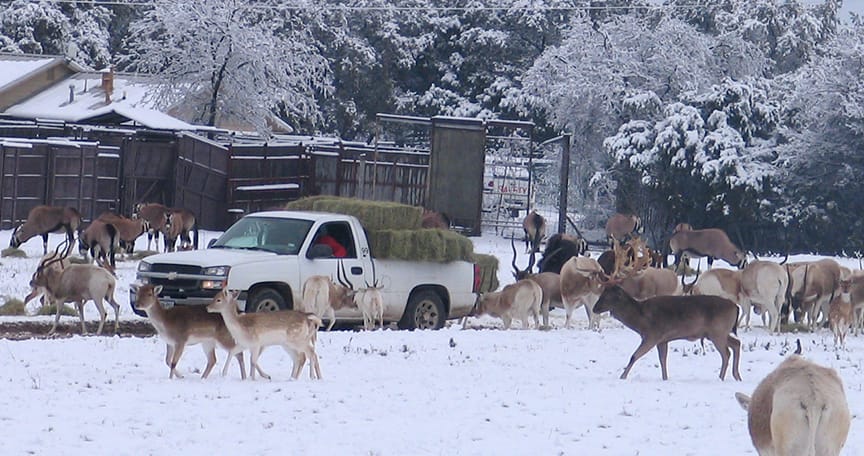
“There is a continual learning curve, as far as how to best provide for the nutritional needs of such a diverse group of animals,” he said. “Grazers are easy, while browsers are very difficult to provide balanced nutrition for. Most zoological institutions have one or more nutritionists, depending on how many species they have, and all meals are prepared in a centralized location. We rely on our veterinary department, our collective experience and also use outside resources as nutritional advisors.”
The staff is fortunate that technology does make it easier to stay abreast of the ever-changing nutritional considerations.
“It is easier to research, communicate and make nutritional changes thanks to improved technology,” Snodgrass said. “As research and practice advances our understanding, we can more readily adjust to meet the nutritional demands of not only a single species, but the individuals within that species, considering age variation and reproductive requirements.”
Carnivores
With an annual rate of roughly $42,000 just for their base meat staple, cheetahs cost a pretty penny to feed at Fossil Rim.
“The cost per pound of the primary meat for our cheetahs is our most expensive food item,” Snodgrass said. “Cheetahs require quality meat with a fat content of 10 percent or less as their main staple. Some of the wolves occasionally receive that meat, too.
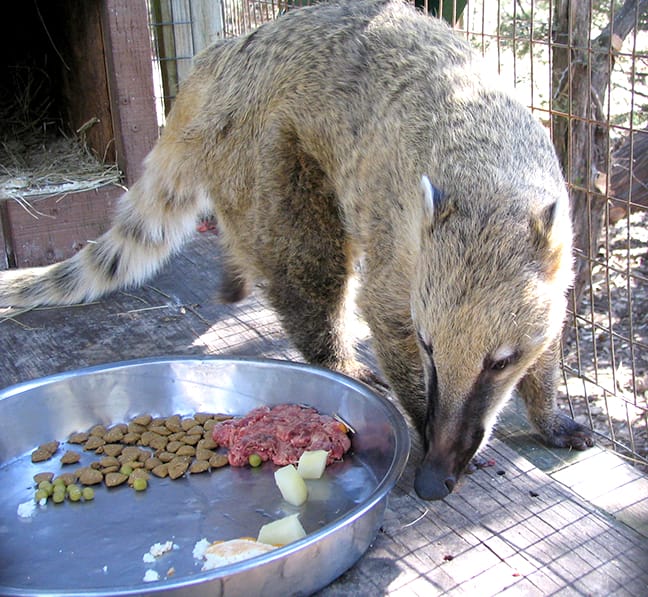
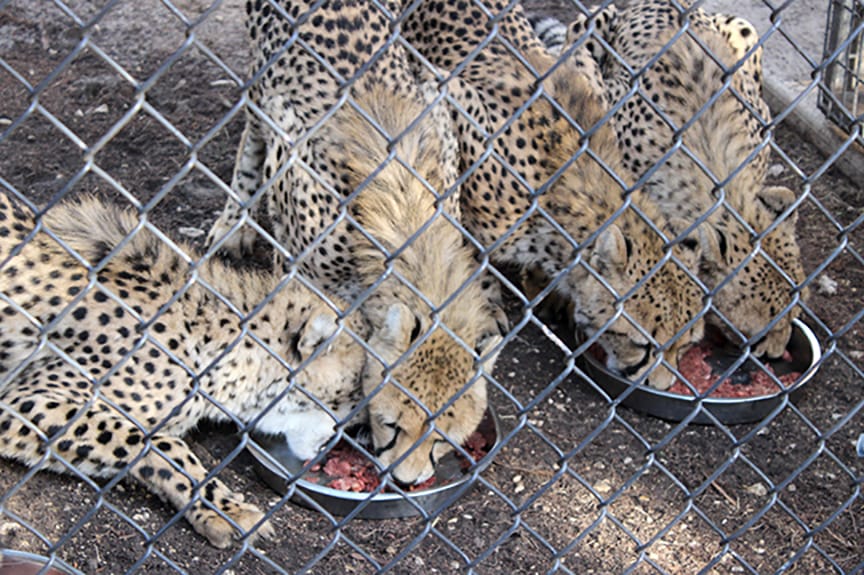
“Mexican wolves and red wolves do pretty well on high-quality dog kibble. We’ll supplement that with some meat and bones as regular treats.”
While black-footed cats join cheetahs as exclusive meat eaters, although consuming far less due to their size, some animals have a wider dietary spectrum.
“Coatis are omnivorous like raccoons; they’ll eat nearly anything,” he said. “They’ll have seasonal preferences, such as desiring meat more in the winter than summer. They also eat fruit, nuts and vegetables.”
They aren’t the only omnivores in the park.
“Maned wolves are a challenge,” Snodgrass said. “In the wild, they eat meat, insects and plants – especially a South American wild tomato family relative. It’s difficult to mirror that in this setting, but we buy a kibble specifically made for them and feed many fruits, vegetables and add a little whole meat protein.”
Hoofstock
As the heaviest animals at Fossil Rim, the pelleted feed for the white rhino herd costs about $14,000 annually and they also eat a significant amount of hay.
While southern black rhinos don’t eat as much, they provide more of a challenge to properly nourish.
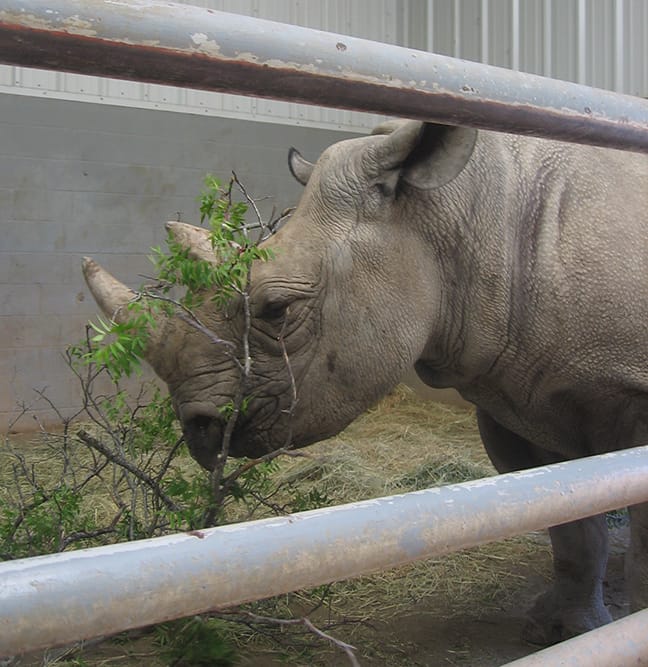
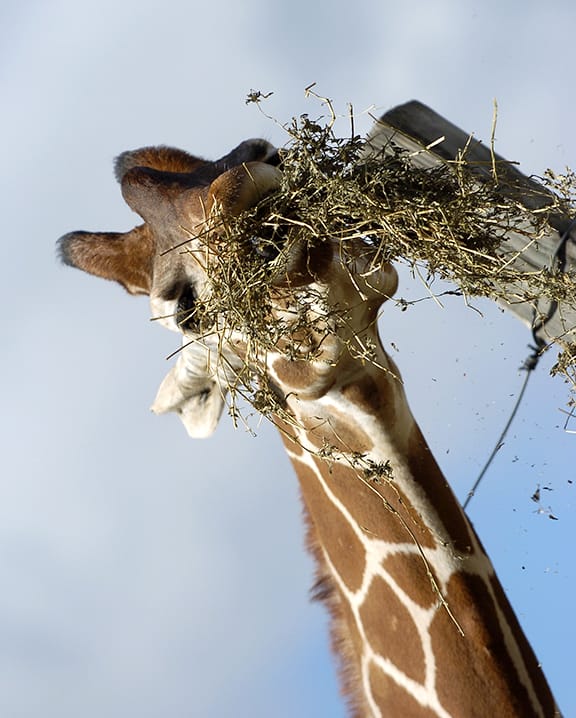
“We still haven’t hit on the best feed selection for black rhinos because of the diversity of plants they would normally browse upon in the wild,” Snodgrass said. “It’s not for a lack of research, and we’re doing better than before. They aren’t grazers, but grass hay is good for them, and they’ve been eating it in addition to a specifically developed pelleted feed.”
Food for the giraffes costs approximately $8,000 each year, not including the alfalfa they thoroughly enjoy.
“As far as plant-based food, the diet needs of our browsers are most expensive,” he said. “It’s more than twice the cost of our normal pasture feed. The top priority is meeting an animal’s nutritional requirements with a balanced diet, and hopefully you find an economical way to do so.”
The varieties of antelopes and equids that roam the pastures also count on pelleted feed as a staple of their diet.
“The (pellet) quantity depends on the season and how much foraging opportunity they have,” Snodgrass said. “If they aren’t foraging, then they’ll need roughage in the form of hay. We also have salt and mineral supplements we give to them on a daily basis.”
Literally not all food pellets are created equally at Fossil Rim.
“The cubes (pellets) for our grazing animals on the pasture are either 14 or 17-percent protein,” he said. “They’ll include some constant staples like corn and alfalfa. But some of the ingredients change based on season and availability of those products. The feed composition has to ensure the nutritional requirements continue to be met.”
Fossil Rim animals can be grouped in a particular pasture according to dietary similarities.
“Except for emu, the Buffer Pasture is a browser-only pasture with the (addra), kudu and bongo,” he said.
Addressing needs and the pecking order
Due to variety even within each species, developing a feeding strategy with a one-size-fits-all approach is challenging because it’s about finding a balance.
“There may be individuals within a herd that have differing nutritional requirements,” Snodgrass said. “For example, a lactating female has different needs than one that isn’t. You have to feed for the lactating female, so a non-lactating animal may receive a little more nutrition than needed. It complicates this scenario further when you factor in multiple species in one pasture.”
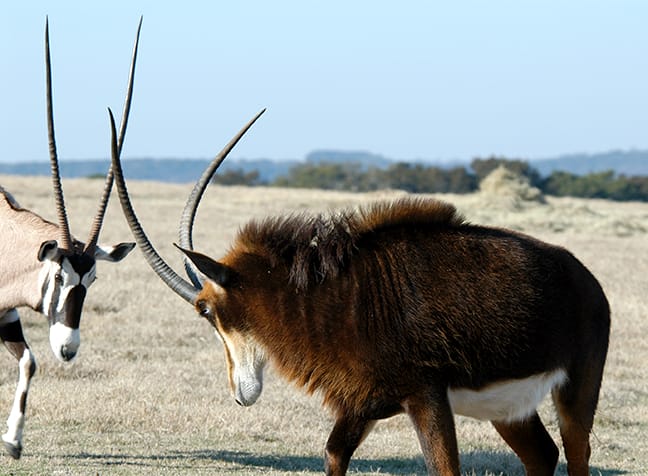
In the Main Pasture, for example, there are sable, addax, gemsbok, waterbuck and a variety of deer.
“You have to look at the social pecking order,” Snodgrass said. “The sable will go to the first feeding station because they are the dominant species in that pasture, followed by gemsbok, addax, all deer species and then waterbuck. You spread the feed out as much as you possibly can to feed as many animals as you can effectively.”
Having grown up together, the different species generally know their place among the population.
“For example, you will see the deer encroaching on each other and moving around during feeding – it’s like a school of minnows,” he said. “Bucks with large antlers will be able to occupy the food line better than a younger buck or a doe. Every now and then, one animal will stand up to another and maybe establish a new order.”
For the birds
Among the avian species, Snodgrass pointed to the Attwater’s prairie chicken (APC) chicks as having an especially notable diet.
“As I said, finding the proper diet for a black rhino is tough, but we’re making continual gains for animals like the APC,” he said. “In 2005, there was a cooperative research effort led by the Fort Worth Zoo to find the optimal feed for this species, and we did. The chicks are fed a blended formula of pelleted food that nutritionally replicates their diet in the wild. The survivability and reproduction program made tremendous gains because of it.”
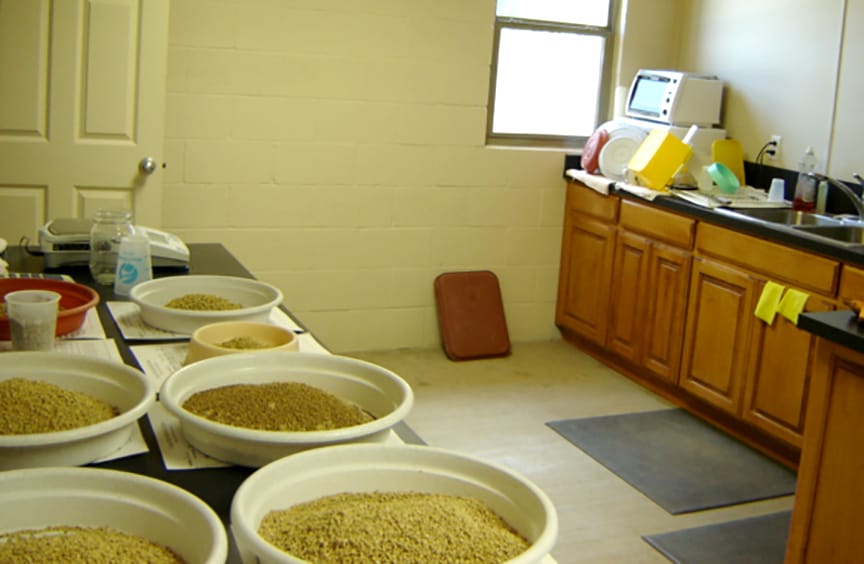
Bird nutrition is also a consideration at the Children’s Animal Center (CAC).
“We buy a certain food for the various parrot species, but you also need to give them fruits and nuts because it is enriching and important physiologically,” Snodgrass said. “For the tortoises, our staff makes one heck of a salad. There are a wide variety of dietary needs just at the CAC.”
Locally grown nourishment
Fossil Rim staff tries to alleviate some of the food costs by finding ways around spending money while keeping animal needs at the forefront.
“We grow all of our own grass hay, at least when we get enough rain, producing large and small bales,” he said. “We plant oats so we can have some limited, seasonal grazing opportunities for our front pasture animals and bale it for hay if we want. We also plant rye grass all over our animal pastures to provide some cool season grazing opportunities.”

Both the local community and a nearby recreation destination continue to lend a hand regarding the animals’ needs.
“Some landowners close to the park allow us to come on their property, and they either donate all the hay that we can cut, haul and bale; or we get half of it,” Snodgrass said. “It’s a wonderful agreement. We have a fantastic agreement with Dinosaur Valley State Park wherein we manage a couple of their fields and get to keep the hay we cut. Both scenarios have been mutually beneficial, but it’s the animals that benefit most.”
Tip of the iceberg
There are many chapters of the epic novel entailing all animal nutrition considerations at Fossil Rim, but Snodgrass is able to summarize the efforts of staff members in this regard.
“It’s a constant balancing act of feeding,” he said. “Some species totally rely on what we provide, while others require constant adjustments based on what they forage on naturally and what we must provide to make up for any nutritional gaps. It all must be done to maintain healthy, productive and active animals.”
-Tye Chandler, Marketing Associate
